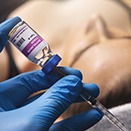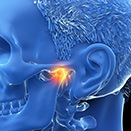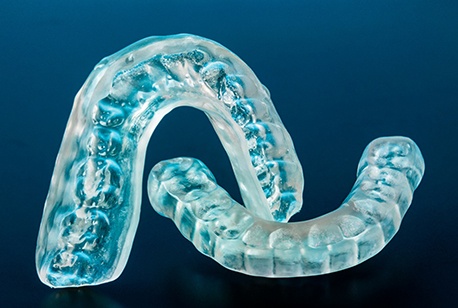TMJ Treatment – Loveland, OH
Putting a Stop to Your Chronic Jaw Pain
Without your TMJ – temporomandibular joint – you wouldn’t be able to chew your favorite foods or speak clearly in front of others. When the TMJ is strained or injured in some way, you may start experiencing chronic jaw pain and other symptoms that could severely disrupt your everyday life. Dr. Gerome and Dr. Patrice are here to help you find a solution for your TMJ disorder; we can diagnose the source of the problem and offer various ways to treat it based on your symptoms. Call us today to schedule an appointment and learn more about your options for TMJ treatment in Loveland.

Why Choose Gerome & Patrice Family Dentistry for TMJ Treatment?
- Comfortable, Personalized Occlusal Splints
- BOTOX® Injections for TMJ Pain Available
- Friendly Team That Helps You Feel at Home
What Is TMJ Disorder?

The TMJ connects the lower jaw to the upper jaw. It’s one of the most complex joints in the entire body; this is so it can give your mouth the freedom of movement it needs to speak, laugh, chew, and perform various other tasks. A TMJ disorder occurs when the TMJ becomes overworked or injured. This could be the result of a blow to the face, or it might be the ultimate result of bite problems, past oral trauma, and bruxism. If you’re experiencing chronic pain or discomfort in your face or jaw, it could mean that you’re currently suffering from a TMJ disorder.
Symptoms of TMJ Disorder

In addition to jaw pain, several other warning signs can point to a TMJ disorder. Common symptoms to watch out for include:
- Your jaw becoming locked in place.
- A clicking or popping sound whenever you open or close your mouth.
- Earaches or a ringing sound in your ears.
- Difficulty while chewing.
- Pain behind your eyes.
- A change in your bite.
It’s a good idea to schedule an appointment if you suspect you might have a TMJ disorder; we can make a full diagnosis so that you can get the right kind of treatment as soon as possible.
Types of TMJ Treatment

To determine whether you have a TMJ disorder, we will take several X-rays of your mouth and jaw joints. Then, depending on our findings, we will discuss the available treatment options with you and explain which one is best for your particular case. Listed below are the different kinds of TMJ treatment that you’ll find here at Gerome & Patrice Family Dentistry; we can go into more detail about each option during your TMJ consultation.
Occlusal Splint

Grinding your teeth at night can make your TMJ symptoms worse. We can address the problem with an occlusal splint, which is an oral appliance that separates the teeth and prevents them from grinding against each other. An occlusal splint can also shift the jaw slightly forward so that the joints can rest more comfortably.
Equilibration/Occlusal Adjustment

Bite problems can cause an uneven distribution of forces in your mouth, which in turn puts unneeded strain on your TMJs. By performing an occlusal adjustment, we can make sure the teeth come together properly to form a more balanced, even bite that allows the muscles and tissues around your jaw joints to relax.
BOTOX® for TMJ Treatment

Believe it or not, BOTOX® can be used for much more than just softening the appearance of fine lines and wrinkles. It can be injected into the muscles that control the jaw to help them relax. You’ll experience relief for several months, at which point you can return to our office for another treatment so that you can continue enjoying the benefits of BOTOX®. Continue reading to learn more about BOTOX® and how it can improve TMD.
What Is BOTOX®?

BOTOX® is a diluted form of the bacteria, botulinum toxin. This formulation is designed to help relax or loosen the muscles. While BOTOX® is often used with cosmetic goals in mind, it can also help treat a variety of painful conditions, including TMD. In a lot of cases, BOTOX® injections for TMD can be completed within 20 to 30 minutes, with the results lasting anywhere from three to four months. It usually takes about 5 to 10 days for the results to become apparent.
Who Is a Good Candidate for BOTOX® TMJ Treatment?

BOTOX® has been helpful for those who are struggling with muscle spasms, jaw tension, and pain in the face due to strained joints and muscles. This quick procedure can provide temporary relief so you can get a break from the discomfort that your TMJ is causing you. BOTOX® for TMJ is generally recommended for people with the following symptoms:
- Jaw discomfort and tenderness
- Limited mobility of the jaw
- Difficulty chewing
- Earaches or ringing in the ears
- Frequent headaches
How Can BOTOX® Treat TMJ Disorder?

BOTOX® isn’t solely used for cosmetic benefits. Using BOTOX® for TMJ disorders helps to effectively reduce pain in your jaw movements for several months. A recent study determined that this method can improve approximately 90% of patient’s TMD symptoms. Injections in the muscles around the jaw joints can help to alleviate a wide range of related symptoms, like headaches, earaches, severe bruxism, and much more!
TMJ Treatment FAQs
Can TMJ Be Cured Permanently?
While some discomfort related to TMJ disorder may naturally subside over time, seeking professional treatment is crucial if symptoms significantly impact your daily life. Certain TMJ treatment approaches, such as BOTOX, can offer temporary pain relief. However, their effects are typically not permanent.
On the other hand, methods like occlusal splints and occlusal adjustments/equilibration are specifically designed to address the root causes of TMD, such as jaw tension or misalignment, providing a more permanent solution and bringing lasting relief.
Is TMJ Treatment Safe?
Yes, TMJ treatment is generally safe when conducted by a qualified professional. The National Institutes of Health recommend approaching TMJ disorder with minimally invasive and conservative methods whenever possible, prioritizing non-surgical options due to associated risks.
Occlusal splints and equilibration/occlusal adjustments have demonstrated overwhelming safety in addressing TMD. While the safety of BOTOX injections for TMD has been debated in research, if recommended by your dentist, it is likely to be considered safe under their professional guidance.
How Long Does It Take for BOTOX to Work for TMJ?
BOTOX injections for TMJ typically reduce discomfort within a few days. Mild bruising and swelling at the injection site may occur but usually subside within 48 hours. Relief from the injections generally lasts for about three to six months, with some patients experiencing longer-lasting effects. The exact duration of relief varies based on genetics and the severity of the disorder.
Typically, a course of at least three injections spread over several weeks is recommended for optimal results. Completing these injections within a shorter timeframe can enhance effectiveness. If BOTOX does not alleviate symptoms, we’ll discuss alternative TMJ treatment options with you.
Is TMJ Treatment Covered by Insurance?
The coverage of TMJ treatment by insurance depends on factors such as the cause, severity, and the specific treatment performed. TMJ, being a joint-related condition, may fall under both medical and dental insurance, but coverage can vary widely. While the TMJ is not exclusively related to dentistry, certain treatments like occlusal splints may be provided by dental professionals.
Generally, insurance companies may not automatically include TMJ coverage unless mandated by the state or requested by company benefit coordinators. It’s recommended to contact your specific insurance provider directly to inquire about coverage for your TMJ treatment.

